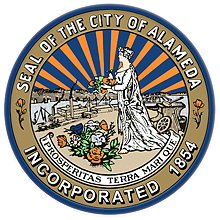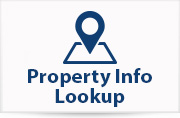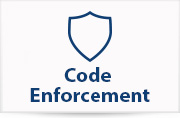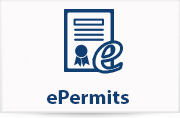 On this page:
On this page:
- Private Sewer Lateral
- Gas Shut-Off Valve
- Carbon Monoxide Detectors
- Soft-Story and Seismic Retrofit Information
- Smoking
- Marsh Crust
Private Sewer Lateral
Effective January 1, 2015
Alameda is Now Part of the EBMUD Regional Private Sewer Lateral Program
For program requirements, click to see the East Bay Municipal Utility District’s Regional Private Sewer Lateral Program
WHAT IS A SEWER LATERAL?
 A sewer lateral is the pipe that conveys sewage from a building's plumbing to the City sewer system. In Alameda, the property owner is responsible for the maintenance and replacement of the upper sewer lateral only - that is the portion of the sewer lateral that is on private property. The City of Alameda is responsible for the lower sewer lateral, which is the portion of the sewer lateral from the property line to the sewer main.
A sewer lateral is the pipe that conveys sewage from a building's plumbing to the City sewer system. In Alameda, the property owner is responsible for the maintenance and replacement of the upper sewer lateral only - that is the portion of the sewer lateral that is on private property. The City of Alameda is responsible for the lower sewer lateral, which is the portion of the sewer lateral from the property line to the sewer main.
This division of responsibility is a bit different if you live in a condominium or homeowners association. Please refer to the Regional Private Sewer Lateral Program's Guidelines for Condominiums and Other Common Interest Developments.
PRIVATE SEWER LATERAL MAINTENANCE REQUIREMENTS:
Your private sewer lateral should be maintained such that it:
- Is free of any roots, grease deposits, and other solids which may obstruct the flow;
- Is watertight and does not have any structural defects, cracks, breaks, openings, rat holes, or missing portions;
- Has a two-way cleanout located at the property line or at the sewer main easement. All cleanouts shall be securely capped with a proper cap at all times; and
- Is free from any non-sewer connections to it (e.g., roof drain, area drain).
These requirements are codified in the Alameda Sewer Lateral Ordinance and EBMUD Private Sewer Lateral Ordinance.
PROBLEMS WITH PRIVATE SEWER LATERALS THAT ARE NOT PROPERLY MAINTAINED:
An unmaintained private sewer lateral has an increased chance of a blockage in the pipe, which can cause raw sewage to back up into a building. This can end up costing the property owner a sum of money to clean up from the impacts.
An unmaintained private sewer lateral also allows stormwater to enter the pipe through cracks and other defects. This can overload the sewer system and treatment facilities during wet weather, resulting in untreated sewage entering the San Francisco Bay.
WHO NEEDS TO FIX THEIR PRIVATE LATERAL AND WHEN?
Please refer to the Regional Private Sewer Lateral Program Triggers.
You may also voluntarily choose to repair or replace your private sewer lateral at any time you feel it necessary (for example, if you are experiencing frequent sewer backups). If this is the case, you are strongly encouraged to get an EBMUD Compliance Certificate to demonstrate that your new or repaired private sewer lateral is free of leaks.
IS A CITY PERMIT REQUIRED FOR PRIVATE SEWER LATERAL WORK?
In most cases, only the EBMUD Compliance Certificate is required, except in cases when:
- The two-way cleanout needs to be installed in the sidewalk area; or
- Your private sewer lateral goes to a back or side yard sewer main.
If work is performed in the sidewalk area, you must also obtain a City Right of Way Concrete permit. The City’s Permit Center administers these permits.
If your private sewer lateral goes to a backyard or other easement sewer main, contact Public Works for easement location and guidance on where to install the two-way cleanout.
Only contractors holding a C-36 - Plumbing Contractor license or C-42 Sanitation System Contractor license should be performing any private sewer lateral repair or replacement work in the City of Alameda. Please refer to EBMUD's Hiring a Contractor Guidelines.
Licensed contractors must follow the California Plumbing Code, as amended by the Alameda Plumbing Code (Chapter 13-6 of the Municipal Code).
TWO-WAY CLEANOUTS TO BE INSTALLED AT THE PROPERTY LINE:
If not already existing, the City requires the property owner to install a two-way cleanout on the sewer lateral at the property line. Please review the City Standard Detail and the property line setback from face of curb schematic. Property line setbacks are block specific; select the applicable map from the index and locate the subject address. Find the Property Line Setback from Face of Curb dimension on that City block. This is where the two-way cleanout should be installed. Any significant deviance from this must be approved by the Public Works Department .
PROGRAM BACKGROUND:
Since the early 1980s, the City of Alameda and other Bay Area communities in the EBMUD wastewater treatment service area have worked together to reduce wet weather sanitary sewer overflows to community streets, local creeks and waterways, and the San Francisco Bay. The replacement of old, cracked sewer pipes can decrease the amount of rainwater infiltration entering the system, which left unaddressed can overwhelm the conveyance and treatment capacity of the wastewater facilities.
The City has an ongoing replacement program for the publicly owned mainline pipes, manholes, pump stations and lower laterals. However, some homes in Alameda have never had their original sewer laterals replaced. Over time, these pipelines, generally made of clay, can crack, become disjointed, experience displacement, and/or be subjected to intrusion by tree roots, all of which can cause leakage and blockage. This Private Sewer Lateral Program is a mechanism to have property owners renew their portion of the sewer system.
Gas Shut-Off Valve
Carbon Monoxide Detectors
All new construction, Interior or exterior alterations, repairs, or additions requiring a permit and having a valuation in excess of $1,000, or when one or more sleeping rooms are added or created, the entire dwelling shall be provided with detectors located as required for a new dwelling.
Soft-Story and Seismic Retrofit Information
The risk of a major earthquake is always present in Alameda, just as it is in much of California. Alameda is renowned for its historic wood-framed architecture, and there are many buildings in the city that are classified as soft-story (where open storefronts or garages are tucked under the building.) The City of Alameda is committed to protecting its residences and limiting damage to its historic architecture. This page includes several documents that inform property owners and contractors about residential seismic strengthening requirements, and provides useful guidance for properties within Alameda’s city limits.
City Ordinances
- Soft-Story Ordinance - contains mandatory compliance requirements (3/18/2009)
- Existing Wood Frame Ordinance - outlines voluntary minimum standards (5/15/2006)
Building Code Guidance
These documents are from the International Existing Building Code Council (IEBCC)
- Residential Seismic Strengthening Plan
- Prescriptive Provisions for Seismic Strengthening
- Earthquake Hazard Reduction (soft-story buildings)
Smoking
On November 15, the Alameda City Council unanimously passed a secondhand smoke ordinance, which prohibits smoking in public outdoor areas and multi-unit housing. More Information
Marsh Crust
What is Marsh Crust?
Before 1900, the areas now occupied by Alameda Point and Bayport were tidal marshlands. Between 1900 and 1940, these marshlands were filled with dredge material. Marsh Crust is the underground layer that is remnant of the tidal marshes and the fill material used to create dry land. This layer contains elevated levels of petroleum-related substances which may pose an unacceptable risk to human health and the environment if excavated and brought to the surface and handled in an uncontrolled manner.
Marsh Crust Permit
Prior to digging in the marsh crust tidal zone (see Marsh Crust Map) you must first determine the depth of your digging. The Marsh Crust Map establishes safe threshold depths with elevations above which there is little likelihood that Marsh Crust will be encountered. If your digging remains above the identified threshold depth, no permit is required. However, if you will be digging below the threshold depth, a Marsh Crust Permit will be required. For more information about the requirements of a Marsh Crust permit, please see the links below.






